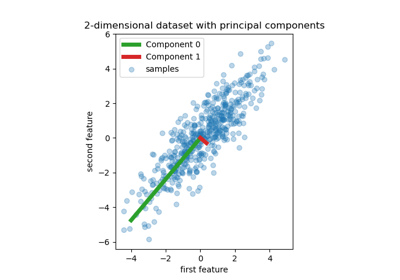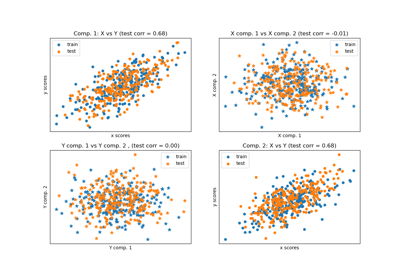sklearn.cross_decomposition.PLSRegression¶
-
class
sklearn.cross_decomposition.PLSRegression(n_components=2, *, scale=True, max_iter=500, tol=1e-06, copy=True)[source]¶ PLS regression
PLSRegression is also known as PLS2 or PLS1, depending on the number of targets.
Read more in the User Guide.
New in version 0.8.
- Parameters
- n_componentsint, default=2
Number of components to keep. Should be in
[1, min(n_samples, n_features, n_targets)].- scalebool, default=True
Whether to scale
XandY.- max_iterint, default=500
The maximum number of iterations of the power method when
algorithm='nipals'. Ignored otherwise.- tolfloat, default=1e-06
The tolerance used as convergence criteria in the power method: the algorithm stops whenever the squared norm of
u_i - u_{i-1}is less thantol, whereucorresponds to the left singular vector.- copybool, default=True
Whether to copy
XandYin fit before applying centering, and potentially scaling. If False, these operations will be done inplace, modifying both arrays.
- Attributes
- x_weights_ndarray of shape (n_features, n_components)
The left singular vectors of the cross-covariance matrices of each iteration.
- y_weights_ndarray of shape (n_targets, n_components)
The right singular vectors of the cross-covariance matrices of each iteration.
- x_loadings_ndarray of shape (n_features, n_components)
The loadings of
X.- y_loadings_ndarray of shape (n_targets, n_components)
The loadings of
Y.- x_scores_ndarray of shape (n_samples, n_components)
The transformed training samples.
- y_scores_ndarray of shape (n_samples, n_components)
The transformed training targets.
- x_rotations_ndarray of shape (n_features, n_components)
The projection matrix used to transform
X.- y_rotations_ndarray of shape (n_features, n_components)
The projection matrix used to transform
Y.- coef_ndarray of shape (n_features, n_targets)
The coefficients of the linear model such that
Yis approximated asY = X @ coef_.- n_iter_list of shape (n_components,)
Number of iterations of the power method, for each component.
- n_features_in_int
Number of features seen during fit.
Examples
>>> from sklearn.cross_decomposition import PLSRegression >>> X = [[0., 0., 1.], [1.,0.,0.], [2.,2.,2.], [2.,5.,4.]] >>> Y = [[0.1, -0.2], [0.9, 1.1], [6.2, 5.9], [11.9, 12.3]] >>> pls2 = PLSRegression(n_components=2) >>> pls2.fit(X, Y) PLSRegression() >>> Y_pred = pls2.predict(X)
Methods
fit(X, Y)Fit model to data.
fit_transform(X[, y])Learn and apply the dimension reduction on the train data.
get_params([deep])Get parameters for this estimator.
Transform data back to its original space.
predict(X[, copy])Predict targets of given samples.
score(X, y[, sample_weight])Return the coefficient of determination \(R^2\) of the prediction.
set_params(**params)Set the parameters of this estimator.
transform(X[, Y, copy])Apply the dimension reduction.
-
fit(X, Y)[source]¶ Fit model to data.
- Parameters
- Xarray-like of shape (n_samples, n_features)
Training vectors, where
n_samplesis the number of samples andn_featuresis the number of predictors.- Yarray-like of shape (n_samples,) or (n_samples, n_targets)
Target vectors, where
n_samplesis the number of samples andn_targetsis the number of response variables.
-
fit_transform(X, y=None)[source]¶ Learn and apply the dimension reduction on the train data.
- Parameters
- Xarray-like of shape (n_samples, n_features)
Training vectors, where n_samples is the number of samples and n_features is the number of predictors.
- yarray-like of shape (n_samples, n_targets), default=None
Target vectors, where n_samples is the number of samples and n_targets is the number of response variables.
- Returns
- x_scores if Y is not given, (x_scores, y_scores) otherwise.
-
get_params(deep=True)[source]¶ Get parameters for this estimator.
- Parameters
- deepbool, default=True
If True, will return the parameters for this estimator and contained subobjects that are estimators.
- Returns
- paramsdict
Parameter names mapped to their values.
-
inverse_transform(X)[source]¶ Transform data back to its original space.
- Parameters
- Xarray-like of shape (n_samples, n_components)
New data, where
n_samplesis the number of samples andn_componentsis the number of pls components.
- Returns
- x_reconstructedarray-like of shape (n_samples, n_features)
Notes
This transformation will only be exact if
n_components=n_features.
-
predict(X, copy=True)[source]¶ Predict targets of given samples.
- Parameters
- Xarray-like of shape (n_samples, n_features)
Samples.
- copybool, default=True
Whether to copy
XandY, or perform in-place normalization.
Notes
This call requires the estimation of a matrix of shape
(n_features, n_targets), which may be an issue in high dimensional space.
-
score(X, y, sample_weight=None)[source]¶ Return the coefficient of determination \(R^2\) of the prediction.
The coefficient \(R^2\) is defined as \((1 - \frac{u}{v})\), where \(u\) is the residual sum of squares
((y_true - y_pred) ** 2).sum()and \(v\) is the total sum of squares((y_true - y_true.mean()) ** 2).sum(). The best possible score is 1.0 and it can be negative (because the model can be arbitrarily worse). A constant model that always predicts the expected value ofy, disregarding the input features, would get a \(R^2\) score of 0.0.- Parameters
- Xarray-like of shape (n_samples, n_features)
Test samples. For some estimators this may be a precomputed kernel matrix or a list of generic objects instead with shape
(n_samples, n_samples_fitted), wheren_samples_fittedis the number of samples used in the fitting for the estimator.- yarray-like of shape (n_samples,) or (n_samples, n_outputs)
True values for
X.- sample_weightarray-like of shape (n_samples,), default=None
Sample weights.
- Returns
- scorefloat
\(R^2\) of
self.predict(X)wrt.y.
Notes
The \(R^2\) score used when calling
scoreon a regressor usesmultioutput='uniform_average'from version 0.23 to keep consistent with default value ofr2_score. This influences thescoremethod of all the multioutput regressors (except forMultiOutputRegressor).
-
set_params(**params)[source]¶ Set the parameters of this estimator.
The method works on simple estimators as well as on nested objects (such as
Pipeline). The latter have parameters of the form<component>__<parameter>so that it’s possible to update each component of a nested object.- Parameters
- **paramsdict
Estimator parameters.
- Returns
- selfestimator instance
Estimator instance.
-
transform(X, Y=None, copy=True)[source]¶ Apply the dimension reduction.
- Parameters
- Xarray-like of shape (n_samples, n_features)
Samples to transform.
- Yarray-like of shape (n_samples, n_targets), default=None
Target vectors.
- copybool, default=True
Whether to copy
XandY, or perform in-place normalization.
- Returns
x_scoresifYis not given,(x_scores, y_scores)otherwise.


